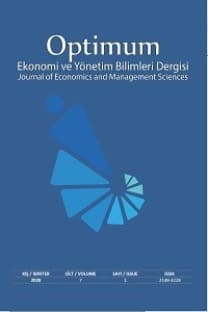Afrika’da Verimlilik, İşgücü ve Yatırım Kamalarının İncelenmesi
Kişi başına gelirdeki ülkelerarası farklılıklar Sahra altı Afrika ekonomileri (Nijerya, Güney Afrika ve Angola) ve Kuzey Afrika ekonomileri (Mısır, Cezayir ve Fas) arasında yüksek olduğu bilinmektedir. Bu makalenin amacı, Afrika’daki 1990-2013 dönemi için gelir farklılıkları olgusunu incelemek ve sonrasında standart neoklasik, küçük açık ekonomi modeline İş Döngüsü Muhasebesi’nin (Chari, Kehoe and McGrattan (2007)) yanı sıra Kalkınma Muhasebesi’nin (Caselli (2005) ve Konya (2013)) birleşik metodolojilerine başvurmaktır. Ulaşılan temel sonuç, verimlilik kaması Afrika’daki gelir farklılıklarını açıklamada önemli bir rol oynamasına rağmen işgücü ve yatırım kamalarının da bu ekonomilerdeki gelir farklılıklarını anlamada önemli olduğu gözükmektedir.
Anahtar Kelimeler:
İş Çevrimi Muhasebesi, Kalkınma Muhasebesi, Işgücü Kaması, Verimlilik Kaması, Yatırım Kaması
Examining the Efficiency, Labor and Investment Wedges in Africa
Cross-country differences in per capita income are known to be high among Sub-Saharan Africa’s economies (Nigeria, South Africa and Angola), and North Africa’s economies (Egypt, Algeria and Morocco). The aim of this paper is hence to examine the phenomenon of income discrepancies in Africa for periods 1990-2013 and then apply the combined methodologies of Development Accounting (Caselli (2005) and Konya (2013)) as well as Business Cycle Accounting (Chari, Kehoe and McGrattan (2007)) in a standard neoclassical, small open economy model. Our main finding is that although efficiency wedge plays an important role in explaining income differences in Africa, labor wedge and investment wedge are also important for understanding income differences in these economies.
Keywords:
Business Cycle Accounting, Development Accounting, Labor Wedge, Efficiency Wedge, Investment Wedge,
___
- Bäurle, G., & D. Burren. (2011). Business Cycle Accounting with Model Consistent Expectations. Economics Letters, 110 (1): 18–19.
- Caselli, F. (2005). In Handbook of Economic Growth, edited by P. Aghion and S. Durlauf, Accounting for Cross-Country Income Differences, 679–741. Elsevier.
- Caselli, F., & J. Feyrer. (2007). The Marginal Product of Capital. The Quarterly Journal of Economics, 122: 535–568.
- Chakraborty, S. & Otsu, K. (2013). Business cycle accounting of the BRIC economies. BE J. Macroeconomics, 13 (1), 381–413.
- Chari, V. V., Kehoe, P. J., & McGrattan, E. R. (2007). Business cycle accounting. Econometrica, 75(3), 781-836.
- Christiano, L. J., & Davis, J. M. (2006). Two flaws in business cycle accounting. NBER Working Papers, 12647, National Bureau of Economic Research.
- Cúrdia, V., & Reis, R. (2010). Correlated disturbances and US business cycles. NBER Working Papers 15774, National Bureau of Economic Research.
- Del Negro, M., & S. Eusepi. (2011). Fitting Observed Inflation Expectations. Journal of Economic Dynamics and Control, 35: 2105–2131.
- Gollin, D. (2002). Getting Income Shares Right. Journal of Political Economy, 110 (2): 458–474.
- Gourinchas, P., & O. Jeanne. (2006). The Elusive Gains from International Financial Integration. Review of Economic Studies, 73: 715–741.
- Hall, R. E., & C. I. Jones. (1999). Why Do Some Countries Produce So Much more Output per Worker than Others? The Quarterly Journal of Economics, 114: 83–116.
- Nutahara, K., & Inaba, M. (2012). An application of business cycle accounting with misspecified wedges. Review of Economic Dynamics, 15(2), 265-269.
- Kersting, E. (2007). The 1980s Recession in the UK: A Business Cycle Accounting Perspective. Review of Economic Dynamics, 11: 179–191.
- Konya, I. (2013). Development accounting with wedges: the experience of six European countries. The BE Journal of Macroeconomics, 13(1), 245-286.
- Kobayashi, K., & M. Inaba. (2006). Business Cycle Accounting for the Japanese Economy. Japan and the World Economy, 18 (4): 418–440.
- Murata, K., Turner, D., Rae, D., & Le Fouler, L. (2000). Modelling manufacturing export volumes equations: a system estimation approach (No. 235). OECD Publishing.
- Nigel, P., Annabelle, M., Franck, S., & Laurence, L.F. (2005). The New OECD International Trade Model. OECD Economics Department Working Papers, 440, OECD Publishing.
- Ohanian, L., A. Raffo, & R. Rogerson. (2008). Long-term Changes in Labor Supply and Taxes: Evidence from OECD Countries, 1956–2004. Journal of Monetary Economics, 55: 1353–1362.
- Otsu, K. (2010). A Neoclassical Analysis of the Asian Crisis: Business Cycle Accounting for a Small Open Economy. The BE Journal of Macroeconomics, 10 (1): 17.
- Prescott, E. C. (2004). Why do Americans Work so much more than Europeans? Quarterly Review, 28: 2–13.
- Pritchett, L. (2000). The Tyranny of Concepts: Cudie (Cumulated, Depreciated, and Investment Effort) is Not Capital. Journal of Economic Growth, 5: 361–84.
- Rogerson, R. (2008). Structural Transformation and the Deterioration of European Labor Market Outcomes. Journal of Political Economy, 116 (2): 235–259.
- Severgnini, B., & Burda, M. C. (2010). TFP Growth in Old and New Europe. Comparative Economic Studies, 51(4), 447-466.
- Valentinyi, A., & B. Herrendorf. (2008). Measuring Factor Income Shares at the Sector Level. Review of Economic Dynamics, 11 (4): 820–835.
- Yayın Aralığı: Yılda 2 Sayı
- Başlangıç: 2014
- Yayıncı: -
Sayıdaki Diğer Makaleler
Afrika’da Verimlilik, İşgücü ve Yatırım Kamalarının İncelenmesi
Sevgi COSKUN, Oyakhilome Wallace IBHAGUİ
Üniversite Öğrencilerinin Gelecekleriyle İlgili Kaygı ve Beklentilerinin Belirlenmesi
Burhanettin ZENGİN, Ümit ŞENGEL
Almanya’nın Kısa Tarihi Mary Fulbrook, İstanbul: Boğaziçi Üniversitesi Yayınevi, 263 sayfa.
Bilgi ve İletişim Teknolojilerinin Türkiye’nin İhracat Performansına Etkisi
Deniz Feyza AYKULTELİ, Ünal TÖNGÜR
Genel Politik Etkinlik Ölçeği: Sağlık Çalışanlarında Bir Ölçek Geliştirme Çalışması
Hilal KUŞCU KARATEPE, Derya ATİK
Mali Teşvik Uygulamaları Açısından Zafer Kalkınma Ajansı Uşak İli İncelemesi
Küreselleşme Yaşam Tatminini Nasıl Açıklar?
